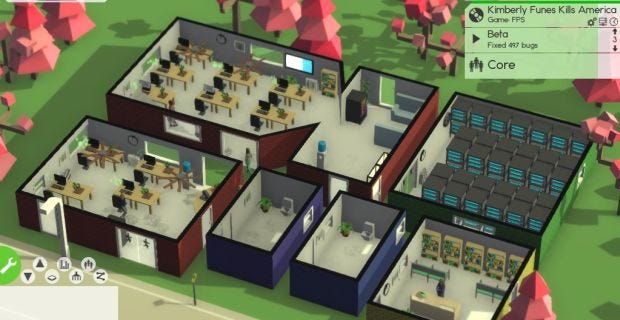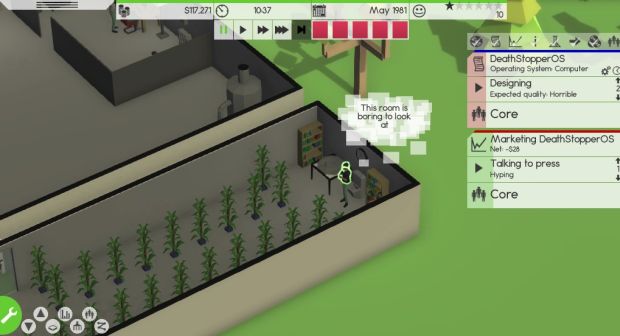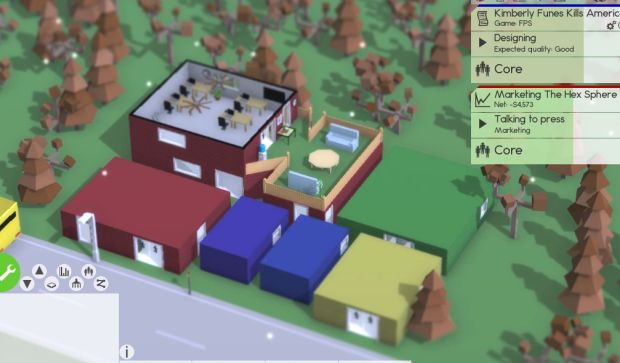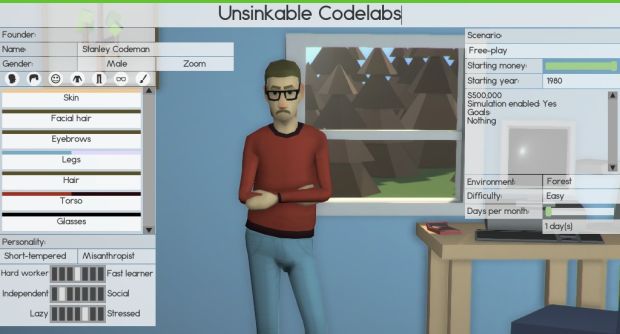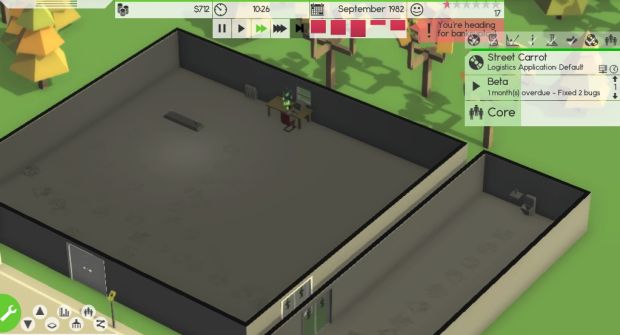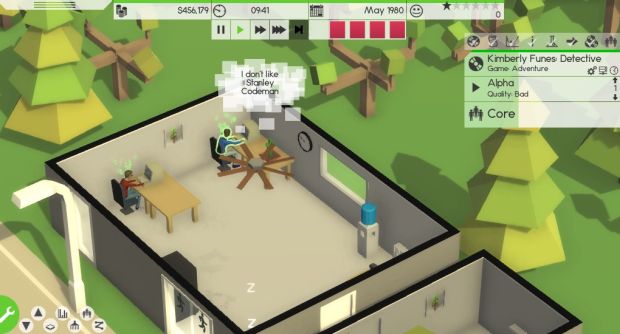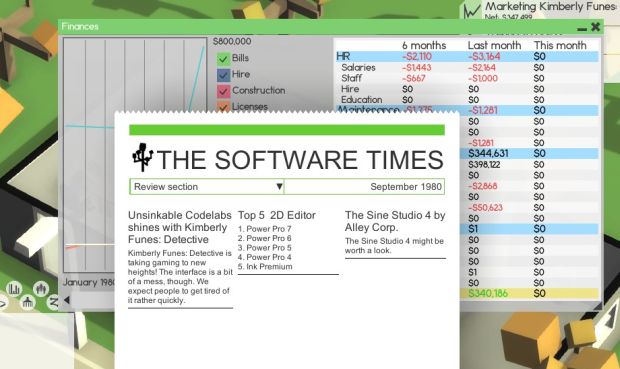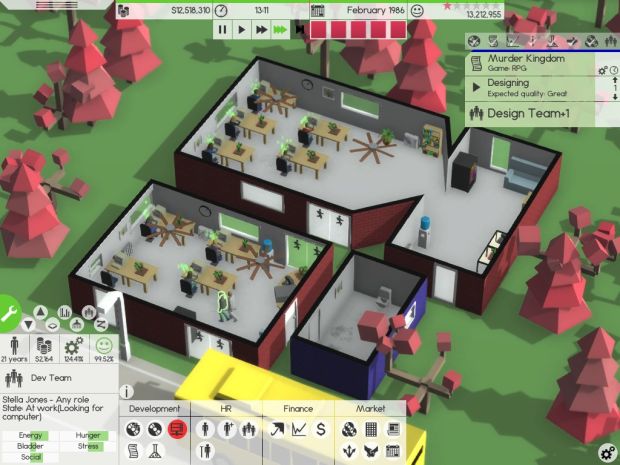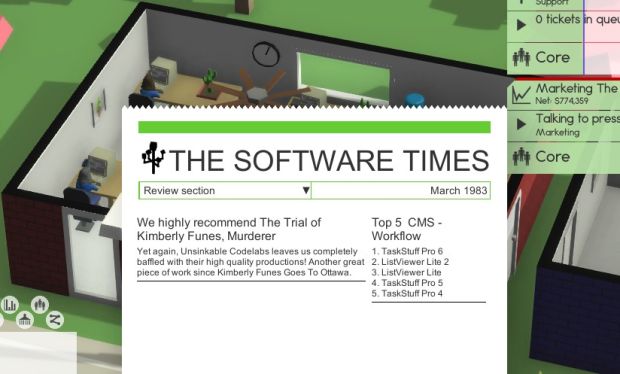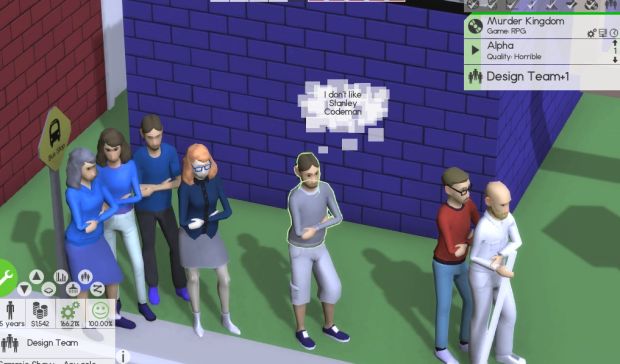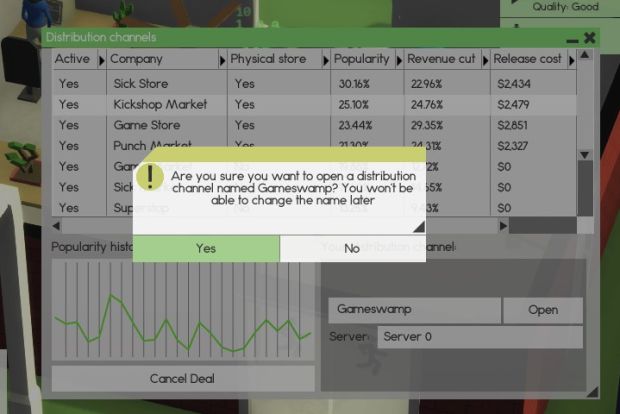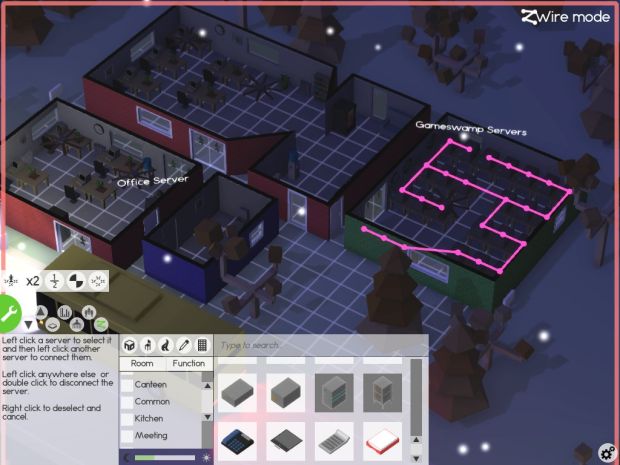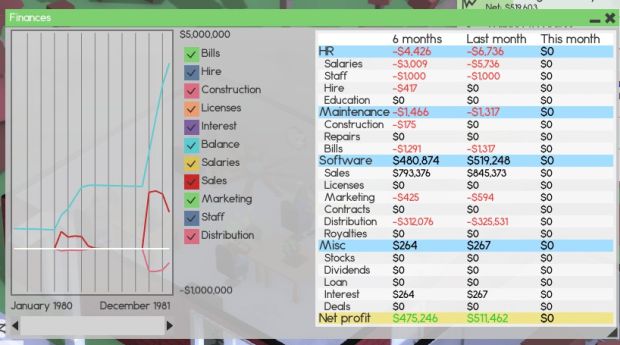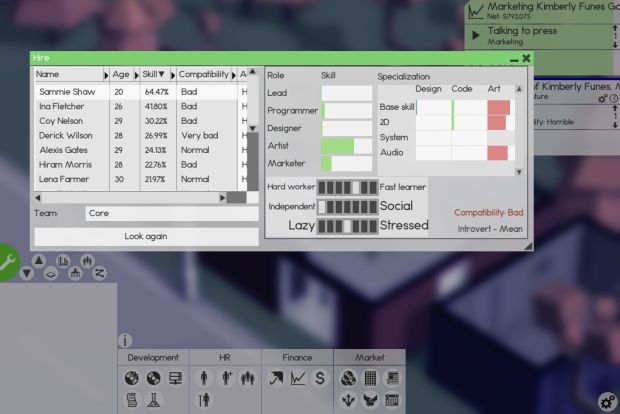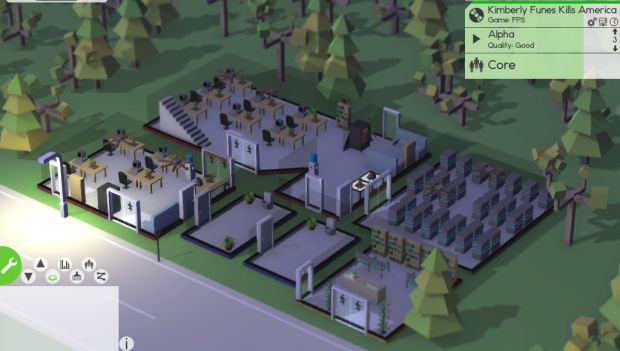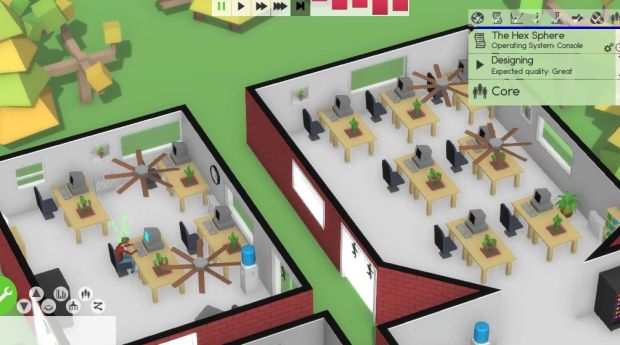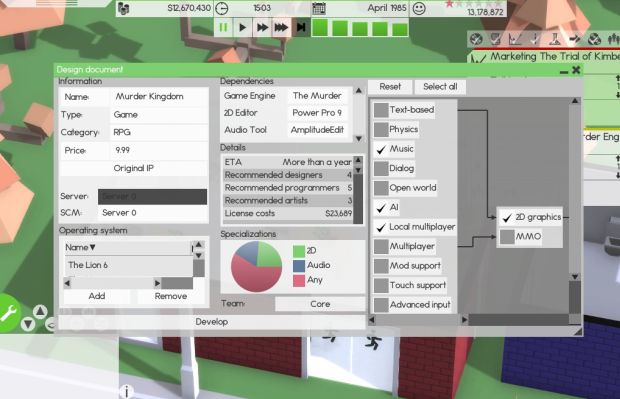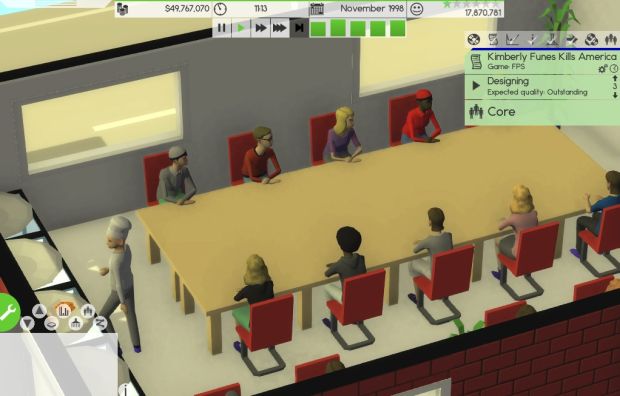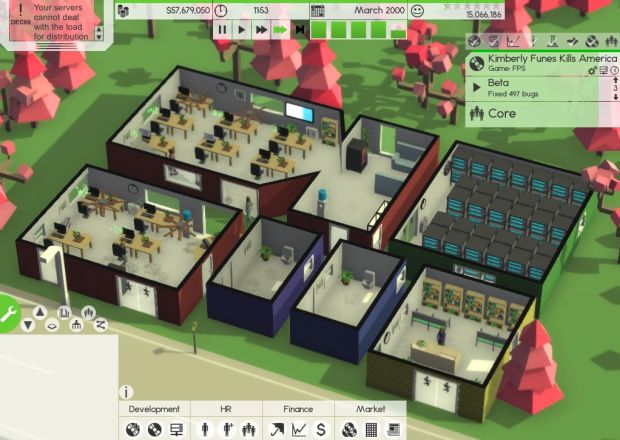Premature Evaluation: Software Inc.
The sad career of Stanley Codeman
Every Monday we send Brendan into a sweltering 1980s office block to sit down at a cubicle and file a report on an early access game. This week, he establishes his own videogame company in Software Inc [Steam page].
“Fail fast.” That’s what the tech magnates of Silicon Valley always say. Stanley Codeman must have taken this philosophy to heart, because the first two enterprises of this short-tempered misanthrope failed spectacularly, both within two years of starting. In hindsight, he probably shouldn’t have taken such high-interest loans and filled his offices with underpaid staff. It was also a bad idea to try and make two hyper-ambitious Operating Systems, back to back. Spending thousands of dollars on a “toilet forest” probably didn’t help.
But it's Stanley's third failure that we all remember.
Software Inc is a management game of creating a small software house and culturing it until it festers into a corporate blight upon the digital kingdom. You start by building a small room or two, staffed by a handful of programmers (or even just your company’s founder) and working on other people’s contracts. If you have the money or the courage, you can develop your own software.
There’s a decent amount of freedom in terms of how you achieve digital dominance. You can make editing tools for creators, business tools for offices, videogames for consoles and (given the time and expertise) even a whole operating system of your own. Selling these and moving onto the next big thing (command-line to GUI, 2D graphics to 3D graphics) will see you expand and grow, and all the while time advances, prompting panicked renovations as you install new computers to each of your employees’ desks in an effort to keep up with the competition.
Sadly, the products don’t appear as anything tangible – there’s no cardboard box to be proud of, or shots of how it looks on-screen. Instead your software appears as entries in the charts, or as reviews in the ‘Software Times’. Sometimes you’ll get a place in a Top 5 listicle and that’s always a good feeling. Then, next year, you’ll see your program’s position slip from 2nd place to 5th and you’ll be fuming. “What the hell is Lion X anyway?” you’ll scream.
Stanley Codeman, famous entrepreneur and failure, knows this feeling all too well. I created him in the game’s scenario and founder editor, giving him negative personality traits because it was funny. I didn’t understand what I was doing. In reality, these traits seemed to even him out, as each trait alters your founder’s mind on three levels: work ethic, aptitude, and sociality. Stanley came away from it quite well-balanced, if a little anti-social. At least, that’s what it looked like at the time.
After our first two bankruptcies, I decided that the high road of systems development would be best left until later. The failures of ‘Rock Paper Solutions’ and the ‘Death Stopper OS’ would not be repeated. The latter of these had left Stanley working in a giant office by himself, hollowed out because I had to fire everyone else and sell all the furniture to stay afloat. Despite these measures, the company still failed, as Stanley insisted on working on a cheap logistics program called 'Street Carrot'.
This time would be different. I took a massive $500,000 “grant” from the game’s generous starter money slider and chose to take things much more slowly. It was time to name the new company. We called it “Unsinkable Codelabs”.
The best way to go about starting our new company was to start small. We hired one programmer who was fairly competent but instantly did not like Stanley. When you hire employees you can filter them by expected salary, skill and compatibility. Winifred was mediocre in terms of skill and “normal” in terms of compatibility. She was also very cheap to pay.
Together her and Stanley began work. We had decided that Unsinkable was going to work on what we knew best – videogames. Stanley began designing the thing that would eventually launch this humble half-a-million dollar company to stardom. It was a text-only adventure game called Kimberly Funes: Detective and it’s main character was about to revolutionise the world of gaming.
This was 1980, you see. Each “day” that passes in the game – each rising and setting of the sun – counts as a ‘month’ of time. We looked at the consoles which had the most active users and bought the licenses for those, then built the game in a matter of months. A little bar at the side of the screen fills up when developing software, going from design stage to alpha to delay (if applicable) to beta. You can click at any time during these phases to advance to the next stage, but doing so too early ensures a bug-filled or non-functioning product. Finally, when you're happy with beta progress, you can click to release. The Software Times, a little newspaper with stories every month about what’s coming out, flashed green. Our game had been reviewed.
“Kimberly Funes: Detective is taking gaming to new heights!” it said. “The interface is a bit of a mess though. We expect people to get tired of it quickly.”
Ooof. Is this the sting that people feel when I review games? Never mind, I thought. Stanley, Winny and I will power on. Within months we had marketed our game so well that we had earned a million dollars in sales. This was it. The beginning of a new era.
In a blistering montage of the 1980s, Unsinkable Codelabs expanded and grew stronger. We fitted new desks, hired artists, programmers, designers and a much-needed cleaner to come and take care of the bathroom. You can also hire maintenance, IT and receptionists to make deals with other companies. We made some distribution deals with a handful of videogame retail stores and as a result, the sequel to our hit adventure game was a resounding success.
Kimberly Funes Goes To Ottawa became the best-selling videogame of all time, moving over 2 million copies worldwide by the end of 1982. It would take a year before it was pushed from this pedestal by none other than the final game in the trilogy - The Trial of Kimberly Funes, Murderer. It was a global sensation. It even had sound effects.
The next few years were a blur. Unsinkable Codelabs had made millions of dollars from these three hits. We built a new wing, and a staff room, hired more artists and programmers. The future was ours. Stanley had a vision. We began work on our own game engine - the Murder Engine™ - which would allow us to create games with 2D graphics. We couldn’t be stopped. That’s when I was looking idly at the list of all released software and discovered the true reason the world was so in love with Kimberly Funes.
All her games were $4.
The average game from our competitors was around $30, and some were as expensive as $40 or $50. Not only were the Kimberly Funes games critically acclaimed and distributed to every game shop in the country, they were also sold so cheap it would be stupid NOT to buy them. We had accidentally become the software world’s most legendary bargain bucket. I looked at the figures and decided not to tell Stanley.
It was around this time that Stanley had his Bright Idea. Now, you might think that Stanley Codeman is just a little character, and that he has no control over the management of this scenario. But, hear me out, because Stanley was a difficult man.
We relied on distributors to sell our games, but what if we cut them out, said Stanley, become our OWN distributor? He was thinking like Valve, like EA, like Ubisoft. I was terrified, and I definitely wasn’t in control of things, if that’s what you’re thinking. He set up a single server on a desk in our office and started the process. Apropos of nothing but a random thought, he had just invented “Gameswamp”. If you wanted to be forgiving, you could say it was ahead of it’s time.
If you wanted to be forgiving.
The server would enter suspended animation within the year, after being unable to cope with the paltry load from the few users who had internet access and wanted to use our shop. But that was not what did the damage. Following the release of our latest game – the critically acclaimed 2D RPG, Murder Kingdom – Stanley wanted to muster that energy into the next big thing. In his lust for an exclusive channel for our next project, he cut off all distribution deals except for Gameswamp, then built a huge server room packed with machines to cope with the foreseen demand of a digital shop that nobody wanted to use.
I didn’t understand. What were we doing? I approached Stanley about it, but he had already begun thinking about the next project.
“We’re going to make a console,” said Stanley (not me).
“A console!” I cried.
“And then we’re going to make the best game ever.”
And that is how the Hex Sphere was born.
We all know now, from our comfortable position in 2002, what a disaster this would turn out to be. Unsinkable Codelabs is still in business and a forty-year-old Stanley Codeman is still technically in charge. In fact, we’re doing better than ever and have just released our fresh IP – the 2D local multiplayer music sim, Krumpstep Megastar. But those were dangerous times.
In Software Inc, you can split your workers into multiple teams and assign them specific rooms and furniture. We had a two-team system – a design team, who had good coffee, and a development team, who had less good coffee. This meant that there were tensions between the teams, and not everyone on the same team always got along anyway, leading to decreased efficiency, which meant the little bars filled more slowly.
But in the early 1990s Stanley dissolved the two-team system entirely and created one “MegaCore” team. He also made it so that people could work in ‘any role’ instead of assigning them specialities, like designer or programmer or artist. Nobody had a title anymore. The effects were astounding. The team worked almost twice as fast and the Hex Sphere OS was soon finished. But it caused whole new problems. The stress was so great it made several people spontaneously stop working in the middle of the afternoon. And some people just didn’t know their own weaknesses. Debora Atkinson always had to be taken away from the art department because she was so dreadful at drawing that she risked ruining anything she worked on.
Thankfully, you can also educate your workers by sending them off for a month or three to train them in a single field. We let Debora retire, because she was 63 and wanted the pension (you have to pay into an insurance pot to attract better workers, but retirees also get that money). But anybody else who tried to do something they weren’t good at, had to be immediately re-educated at the company’s cost.
That summer everyone took their usual July holiday. Every year this happens, and Stanley Codeman comes into the office and works alone. Just him and the cleaner. In 1991, the Hex Sphere was reaching the end of its design phase. By January 1993 it was finished. Two years of solid work had produced a machine that shocked the world. It sold just 18,000 consoles.
We couldn’t understand it. The OS was incredibly robust, ranked as ‘outstanding’ on the spreadsheet of releases. “A beautiful piece of engineering” said the Software Times. The most impressive console ever to be made. Far better than The Lion 5 and the Pen OS – the randomly generated names for consoles from two of Software Inc’s other popular companies. This was the worst sales record for our company since the botched 1989 ‘Tragic Bootcamp Adventure’, a text-based mess which the Software Times described as “broken, is anyone surprised?”
I tried to speak to Stanley, to get him to renegotiate our distribution deals, to forget about Gameswamp and the Hex Sphere. We needed to go back to developing traditional games for existing consoles like the Lion and the Pen. But you know Stanley, he’s not like me, Brendan Caldwell, and he certainly isn’t being injected with dramatic character in order to exonerate me from all blame, if that's what you suspect.
I found him in the new staff canteen one summer, alone, and confronted him. He was furious.
“WE WILL FINISH WHAT WE STARTED,” he yelled, quickly wiping his nose.
And so it was. The plans for the next game went ahead. Our “killer app”, the one we would develop for the Hex Sphere and the Hex Sphere alone. By Stanley’s logic, it would drive sales of the machine. “This will be our Halo,” he often said to me, sweating. “Kimberly Funes Kills America will be the greatest FPS that was ever made.”
It was true, we had the design finely tuned – a 3D first-person-shooter with HD sound and local multiplayer. A game like that didn’t exist yet. It would take the Hex Sphere into the stratosphere. The programmers went over it like archaeologists with tiny brushes, sweeping away each bug, each flaw, until only the pristine game remained. I watched the green bar fill, slowly, until the beta report read ‘outstanding’. The game was finally released in the year 2000. Seven years after the Hex Sphere itself.
“Kimberly Funes Kills America is a masterpiece” read the headline in the Software Times. But the sales figures told a different story. We had sold just two copies of the game.
Two.
Critically, Kimberly's latest misadventure was rated as a work of art, but its development had also been a total farce. Of the 18,000 people who bought a Hex Sphere way back in 1993 only 2 customers were loyal enough to buy the long-awaited return of desperate anti-hero Miss Funes in FPS form. We had even renegotiated to sell it in all shops, and sold it at our characteristically bargain bucket prices – a mere $14.99. And still, nobody bought it. Nobody bought a Hex Sphere either. It was not our Halo. Instead, it become the most critically acclaimed 1.4 million dollar loss in the history of videogames.
Stanley was dejected. He left the office without saying anything and came back the next day, quieter, and tired-looking. Thankfully, I had been making clandestine deals with dodgy anti-virus companies to host their data and downloads on the Gameswamp servers. We had accidentally become the fastest and most reliable server farm in the business, following my quiet closure of the Gameswamp digital shopfront.
Unsinkable Codelabs has made 60 million dollars in the last ten years via its hosting services for these software giants. We’re back to making games for other consoles now. And who knows, maybe Kimberly Funes will make a return. But I look at Stanley Codeman sitting in the canteen, on a lonely July day when everyone has gone on holiday, and I can’t help but think: how long until the real Stanley comes back? It took us seven years to make the world’s biggest flop.
That’s not what I’d call failing "fast."
Software Inc is available on Steam for £10.59/$13.99. These impressions were based on build 1311279
